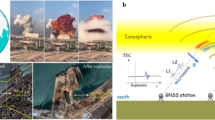Abstract
IT is important both for the understanding of the nature of the localized radio sources and the determination of interstellar radio absorption to extend the measurement of the spectra of the sources to as low radio-frequencies as possible. Ionospheric transmission sets a limit, but by choosing frequencies not too close to the critical frequency, and restricting observations to days of low ionospheric disturbance, reasonably accurate measurements may be obtained. In this way, we have recently made measurements at a frequency of 22.6 Mc./s. (λ = 13.3.m.) by means of an interferometer consisting of two aerials spaced in the east–west direction at 20 wave-lengths apart, thus producing lobes in the aerial pattern at intervals of about 3°. Each aerial consists of an array of six full-wave dipoles giving a vertically directed beam of width ± 22° and ± 9° in the north–south and east–west directions respectively. The recording apparatus is a simplified form of the type described by Machin, Ryle and Vonberg1, whereby the receiver is continually switched to a standard noise diode source which is automatically adjusted by a servo-mechanism to equalize the received radiation.
This is a preview of subscription content, access via your institution
Access options
Subscribe to this journal
Receive 51 print issues and online access
$199.00 per year
only $3.90 per issue
Buy this article
- Purchase on Springer Link
- Instant access to full article PDF
Prices may be subject to local taxes which are calculated during checkout
Similar content being viewed by others
References
Machin, K. E., Ryle, M., and Vonberg, D. D., Proc. Inst. Elect. Eng., 99, Pt. III, 127 (1952).
Brown, R. Hanbury, Jennison, R. C., and Das Gupta, M. K., Nature, 170, 1061 (1952).
Jennison, R. C., and Das Gupta, M. K., Nature, 172, 996 (1953).
Stanley, G. J., and Slee, D. B., Aust. J. Sci. Res., A, 3, 234 (1950).
Ryle, M., Smith, F. G., and Elsmore, B., Mon. Not. Roy. Astro. Soc., 110, 508 (1950).
Brown, R. Hanbury, and Hazard, C., Mon. Not. Roy. Astro. Soc., 113, 123 (1953).
Mills, B. Y., Aust. J. Sci. Res., A, 5, 266 (1952).
Observatory, 73, 188 (1953).
Hubble, E., Astrophys. J., 79, 8 (1934).
Muller, C. A., and Oort, J. H., Nature, 168, 357 (1951).
Christiansen, W. N., and Hindman, J. V., Aust. J. Sci. Res., A, 5, 437 (1952).
Scheuer, P. A. G., and Ryle, M., Mon. Not. Roy. Astro. Soc., 113, 3 (1953).
Piddington, J. H., and Minnett, H. C., Aust. J. Sci. Res., A, 5, 17 (1952).
Author information
Authors and Affiliations
Rights and permissions
About this article
Cite this article
HEY, J., HUGHES, V. Intensities of Discrete Radio Sources in Cygnus and Cassiopeia at 22.6 Mc.s.. Nature 173, 819–820 (1954). https://doi.org/10.1038/173819a0
Issue Date:
DOI: https://doi.org/10.1038/173819a0
Comments
By submitting a comment you agree to abide by our Terms and Community Guidelines. If you find something abusive or that does not comply with our terms or guidelines please flag it as inappropriate.



